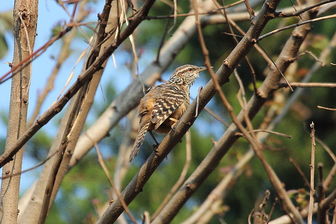Band-backed Wren
The Band-backed Wren is a resident breeding species from south-central Gulf Coast Mexico to northwestern Ecuador. It occurs in five disjunct areas, the central region being in southern Central America, in Costa Rica and northern Panama. The next two regions are northern Colombia adjacent to Panama, and 800 km to the south in northwestern Ecuador.

Original source: Dominic SheronyPermission(Reusing this file)This image, which was originally posted to Flickr.com, was uploaded to Commons using Flickr upload bot on 10:49, 1 June 2011 (UTC) by DreamOfShadows (talk). On that date it was licensed under the license below. This file is licensed under the Creative Commons Attribution-Share Alike 2.0 Generic license.You are free:to share – to copy, distribute and transmit the work
Author: Dominic SheronyPermission(Reusing this file)This image, which was originally posted to Flickr.com, was uploaded to Commons using Flickr upload bot on 10:49, 1 June 2011 (UTC) by DreamOfShadows (talk). On that date it was licensed under the license below. This file is licensed under the Creative Commons Attribution-Share Alike 2.0 Generic license.You are free:to share – to copy, distribute and transmit the work
The Band-backed Wren is classified as Least Concern. Does not qualify for a more at risk category. Widespread and abundant taxa are included in this category.
The Band-backed Wren, Campylorhynchus zonatus, is a small songbird of the wren family. The Band-backed Wren is a resident breeding species from south-central Gulf Coast Mexico to northwestern Ecuador. It occurs in five disjunct areas, the central region being in southern Central America, in Costa Rica and northern Panama. The next two regions are northern Colombia adjacent to Panama, and 800 km to the south in northwestern Ecuador. More
The Band-backed Wren (Campylorhynchus zonatus) is a small songbird of Wren family. Distribution / Habitat It is a resident breeding species from central Mexico to northwestern Ecuador. This large wren breeds in lowlands and foothills from sea level up to 1700 m altitude in thinned forest or open woodland, scrub, second growth and groves around houses. It mainly occurs on the Caribbean side of the central mountain ranges. More
Band-backed Wrens are common here, and that's OK with me because they cheer up anyplace they happen to be. Like a lot of wrens they're not only noisy but also nosey, unable to contain their curiosity when someone comes down a trail, so they come orbiting around you making their funny sounds. The genus Campylorhynchus is an important one. More
The adult Band-backed Wren is 16.5 cm long and weighs 29 g. It has a brown-grey crown, black nape, and the rest of the upperparts and tail are heavily barred with black, tawny and white. The breast and throat are white, heavily spotted with black, and the belly is cinnamon. Young birds have duller upperparts and off-white to buff underparts. This species has a short rasping zek call. The song is a mix of dry chatters, splutters and gurgles. More
Band-backed Wren (Campylorhynchus zonatus) by Don Jones. More
Family : Troglodytidae
Genus : Campylorhynchus
Species : zonatus
Authority : (Lesson, 1832)
